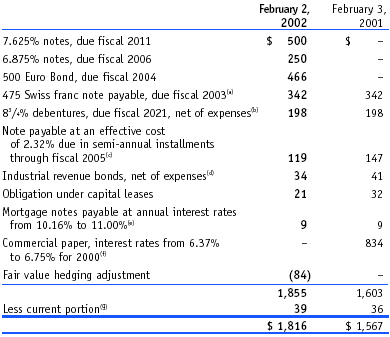
 |
|||||
| |
|
|
|
|
|
|
SEASONAL FINANCING AND LONG-TERM DEBT 
On February 13, 2001, the company issued and sold 500 EURO through the public issuance of a EURO bond bearing interest at 6.375% per annum. Through the use of derivative instruments, this obligation was swapped into a $466 fixed rate obligation at an effective rate of 7.43% per annum with interest payments due annually and principal due on February 13, 2004. Accordingly, the company reclassified $466 from short-term borrowings to long-term debt at February 3, 2001. On July 19, 2001, the company issued and sold $500 of notes bearing interest at 7.625% per annum maturing on August 1, 2011 and $250 of notes bearing interest at 6.875% per annum maturing on August 1, 2006. Simultaneously, the company entered into interest rate swap agreements. As a result of the interest rate swap agreements, interest on the $500 notes will accrue at the rate of LIBOR plus 1.5120% per annum and interest on the $250 notes will accrue at the rate of LIBOR plus 1.1515% per annum. Interest is payable on both notes semi-annually on February 1 and August 1 of each year, commencing on February 1, 2002. Long-term debt balances as of February 2, 2002 have been impacted by currency and interest rate swaps entered into during fiscal 2001, as discussed in the footnote “Derivative Instruments and Hedging Activities.” The company has a $975 unsecured committed revolving credit facility from a syndicate of financial institutions. The credit facility includes a $650 5-Year facility expiring in September 2006 and a $325 364-Day facility expiring in September 2002. This facility is available for seasonal borrowings and to support the company’s domestic commercial paper borrowings. There were no outstanding balances under any of these committed revolvers at the end of fiscal 2001, 2000 or 1999. Additionally, the company has lines of credit with various banks to meet short-term financing needs of its foreign subsidiaries. Cash requirements for operations, capital expenditures and lease commitments will be met primarily through operating activities and issuance of equity and/or debt. During 2000, the company classified $368 of commercial paper as long-term debt, as the company maintained long-term committed credit agreements, as described above, to support these borrowings and intended to refinance them on a long-term basis. This amount was repaid out of the proceeds of the 7.625% notes discussed above. The weighted-average interest rate on short-term borrowings outstanding at February 3, 2001 was 6.6%. There were no short-term borrowings outstanding at February 2, 2002. The annual maturities of long-term debt at February 2, 2002 are as follows: DERIVATIVE INSTRUMENTS AND HEDGING ACTIVITIES The company is exposed to market risk from potential changes in interest rates and foreign exchange rates. The company regularly evaluates these risks and has taken the following measures to mitigate these risks: the countries in which the company owns assets and operates stores are politically stable; the company’s foreign exchange risk management objectives are to stabilize cash flow from the effects of foreign currency fluctuations; the company does not participate in speculative hedges; and the company will, whenever practical, offset local investments in foreign currencies with borrowings denominated in the same currencies. The company also enters into derivative financial instruments to hedge a variety of risk exposures including interest rate and currency risks. |
| |